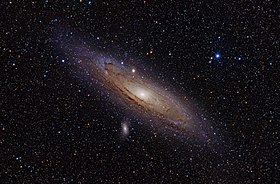Galaxy M31
| Andromeda Galaxy | |
|---|---|

The Andromeda Galaxy
|
|
| Observation data (J2000 epoch) | |
| Pronunciation | /ænˈdrɒmɪdə/ |
| Constellation | Andromeda |
| Right ascension | 00h 42m 44.3s |
| Declination | +41° 16′ 9″ |
| Redshift | z = −0.001001 (minus sign indicates blueshift) |
| Helio radial velocity | −301 ± 1 km/s |
| Distance | 2.54 ± 0.11 Mly (778 ± 33 kpc) |
| Apparent magnitude (V) | 3.44 |
| Absolute magnitude (V) | −21.5 |
| Characteristics | |
| Type | SA(s)b |
| Mass |
~0.8-1.5×1012 M☉ |
| Number of stars | ~1 trillion (1012) |
| Size | ~220 kly (diameter) |
| Apparent size (V) | 3.167° × 1° |
| Other designations | |
| M31, NGC 224, UGC 454, PGC 2557, 2C 56 (Core), CGCG 535-17, MCG +07-02-016, IRAS 00400+4059, 2MASX J00424433+4116074, GC 116, h 50, Bode 3, Flamsteed 58, Hevelius 32, Ha 3.3, IRC +40013 | |
~0.8-1.5×1012
The Andromeda Galaxy (/ænˈdrɒmɪdə/), named after the mythological Princess Andromeda, also known as Messier 31, M31, or NGC 224, is a spiral galaxy approximately 780 kiloparsecs (2.5 million light-years) from Earth, and the nearest major galaxy to the Milky Way. Its name stems from the area of the sky in which it appears, the constellation of Andromeda.
The 2006 observations by the Spitzer Space Telescope revealed that the Andromeda Galaxy contains approximately one trillion stars, more than twice the number of the Milky Way’s estimated 200-400 billion stars. The Andromeda Galaxy, spanning approximately 220,000 light years, is the largest galaxy in our Local Group, which is also home to the Triangulum Galaxy and other minor galaxies. The Andromeda Galaxy's mass is estimated to be around 1.76 times that of the Milky Way Galaxy (~0.8-1.5×1012 solar masses vs the Milky Way's 8.5×1011 solar masses).
The Milky Way and Andromeda galaxies are expected to collide in ~4.5 billion years, merging to form a giant elliptical galaxy or a large disc galaxy. With an apparent magnitude of 3.4, the Andromeda Galaxy is among the brightest of the Messier objects - making it visible to the naked eye on moonless nights, even when viewed from areas with moderate light pollution.
...
Wikipedia
